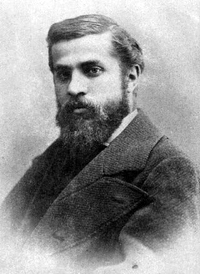 Antoni Gaudi (1852 – 1926) was a Spanish Catalan architect, who belonged to the Modernisme (Art Nouveau) movement and was famous for his unique style and highly individualistic designs.
Antoni Gaudi (1852 – 1926) was a Spanish Catalan architect, who belonged to the Modernisme (Art Nouveau) movement and was famous for his unique style and highly individualistic designs.
Gaudi was born in the province of Tarragona in southern Catalonia, Spain in 1852. While there is some dispute as to his birthplace – official documents state that he was born in the town of Reus, whereas others claim he was born in Riudoms, a small village 3 miles (5 km) from Reus, – it is certain that he was baptized in Reus a day after his birth. The artist's parents, Francesc Gaudi Serra and Antonia Cornet Bertran, both came from families of metalsmiths.
The youngest of five, Gaudi found he was too lame to play with friends his own age because of rheumatism. (Some believe he only had arthritis in his hands and could, in fact, take walks.) Because he was in considerable pain, he was rarely able to walk on foot and was forced to ride a donkey when he wanted to venture from his home. The fact that he remained close to home allowed him substantial free time to inspect nature and its design. It has been hypothesized that it was this exposure to nature at an early age that began to hone two of his greatest qualities: observation and the analysis of nature.
Gaudi, as an architecture student at the Escola Tecnica Superior d'Arquitectura in Barcelona from 1873 to 1877, achieved only mediocre grades but did well in his "Trial drawings and projects". After five years of work, he was awarded the title of architect in 1878. As he signed Gaudí's title, Elies Rogent declared, "Qui sap si hem donat el diploma a un boig o a un geni: el temps ens ho dirà" ("Who knows if we have given this diploma to a nut or to a genius. Time will tell.").The newly named architect immediately began to plan and design and would remain affiliated with the school his entire life.
Early career
- 1878–1879: Lampposts for the Plaça Reial at Barcelona;
- 1878: Showcase for glove manufacturer Comella. Via this work, used at the World's Fair in Paris, Eusebi Güell came to know the architect.
- 1878–1882: Several designs for the Obrera Mataronense at Mataro. Only a very small part of these plans was built, but it shows Gaudí's first use of parabolic arches, here in a wooden structure.
- 1883–1885: Casa Vicens;
- 1883–1885: Villa "El Capricho" at Comillas (Santander);
- 1884: Finca Guell: Entrance pavillion and stables for the palace at Pedralbes (first completed building for Eusebi Guell);
- 1884–1891: Completion of the crypt of the Sagrada Família (the crypt had been started by the architect Francisco del Villar in 1882, who had to abandon the project in 1883);
- 1885–1889: Palau Guell;
- 1887–1893: Episcopal palace at Astorga;
- 1889–1894: Colegio Teresiano;
- 1891–1893: Outer walls of the absis of the Sagrada Família;
- 1892–1894: Casa de los Botines at Leon.
Artistic style
Gaudi's first works were designed in the style of gothic and traditional Spanish architectural modes, but he soon developed his own distinct sculptural style. French architect Eugene Viollet-le-Duc, who promoted an evolved form of gothic architecture, proved a major influence on Gaudí. But the student surpassed the master architect and contrived highly original designs – irregular and fantastically intricate. Some of his greatest works, most notably La Sagrada Família, have an almost hallucinatory power.
He integrated the catenary arch and hyperboloid structures, nature's organic shapes, and the fluidity of water into his architecture. While designing buildings, he observed the forces of gravity and related catenary principles. Gaudí designed many of his structures upside down by hanging various weights on interconnected strings or chains, using gravity to calculate catenaries for a natural curved arch or vault. Using the trencadís technique, Gaudí often decorated surfaces with broken tiles. The architect's work was categorized as Art Nouveau architecture, a precursor to modern architecture. But his adoption of biomorphic shapes rather than orthogonal lines put him in a category unto himself.
Major works
- Casa Vicens (1878–1880)
- Palau Guell (1885–1889)
- College of the Teresianas (1888–1890)
- Crypt of the Church of Colonia Guell (1898–1916)
- Casa Calvet (1899–1904)
- Casa Batllo (1905–1907)
- Casa Mila (La Pedrera) (1905–1907)
- Park Guell (1900–1914)
- Sagrada Família Nativity façade and Crypt of the Sagrada Familia cathedral (1884–1926)

